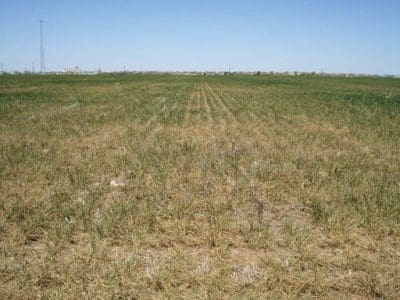IN a year when winter crops in many regions have gone through a tough season, farmers are facing the challenge of what to do with poor or failed crops.
 One season is rarely the same as the next and while most are rewarding, sometimes grain crops are compromised by drought, frost or heat stress and you may be faced with the difficult decision of changing the crop outcome to recoup costs and hopefully profit.
One season is rarely the same as the next and while most are rewarding, sometimes grain crops are compromised by drought, frost or heat stress and you may be faced with the difficult decision of changing the crop outcome to recoup costs and hopefully profit.
After careful assessment of damage, you should decide whether to allow the crop to continue-on to fill grain, graze with livestock, or cut it early for silage or hay.
Understanding what has happened to the plant and how it has been affected, will help determine the potential for further growth of dry matter and grain and the most ideal outcome.
If you can make the decision early, you’ll avoid wasting time and money.
Consider the following when deciding alternative outcomes for compromised crops:
(adapted from ‘Feed planning pays off’, Hamish Dickson, AgriPartner Consulting, MLA website)
Chemical withholding periods
If the crop is to be consumed by livestock, consider what chemicals have been used on the crop during the growing season and their withholding periods (WHPs); the minimum time between the last application of the chemical and using the crop, in this case for grazing or stock feed or grain. Keeping chemical history records helps provide evidence for livestock or stockfeed vendor declarations, and Livestock Production Assurance (LPA) requirements.
If the crop will be grazed:
Nutritional quality: Feed test the crop so you understand its nutritional value for animals.
Livestock class: What are the feed demands of different classes of livestock – does the crop meet these requirements, are supplements needed, which group of animals will be best suited to grazing that crop?
Timing: How mature is the crop, and how soon can livestock enter the crop – how does that affect feed quality?
Crop management: Will the crop be spray topped before grazing, how will that effect quality and WHPs?
Animal health: Be aware of issues such as pulpy kidney and acidosis – has grain formed in the head? Nitrate poisoning may be a risk on canola and oat crops. Manage mineral nutrition and supplement with calcium and magnesium when grazing cereal crops (limestone:Causmag:salt 2:2:1).
If the crop will be cut for hay or silage:
End product: What bests suits your enterprise? What type of hay or silage can you utilise or sell?
Nutritional quality: What stage of maturity is the crop, will it make a quality product? Feed test to understand the nutritional value.
Capabilities: Are contractors or skilled operators available to make the hay or silage?
Management: Are you able to store the fodder, and manage risks such as hay stack fires? What is your capacity to handle or market fodder?
Utilisation: Feed budget to match the quality and volume of product to the livestock class which will benefit the most.
If the crop is harvested for feed quality grain:
Nutritional quality: Feed test the grain to understand its nutritional value.
Feed budget: Determine which class of livestock is best suited to consuming the grain based on energy and protein requirements, and formulate an appropriate ration.
Supplementation: Grain and low-quality crop stubbles may not entirely meet an animal’s needs and mineral supplementation may be required. Calcium supplementation is essential when grazing cereal stubbles and grain.
Introduction of grain: Imprint feeding is essential with all supplementary grains. The risk of acidosis is high in sheep and cattle and can be reduced with gradually introducing the grain and seeking advice from advisers.
………………………………..
A calculator ‘Salvaging crops for fodder, grain or grazing – costs and income calculator’ has been developed by the NSW DPI to help producers make crop outcome decisions. Input data for your own situation to assess the cost of each option and the end product’s potential value, which can then be used to make a better decision knowing the best economic outcomes.
This article was originally published on the Birchip Cropping Group website and newsletter – click here to view original article.

HAVE YOUR SAY